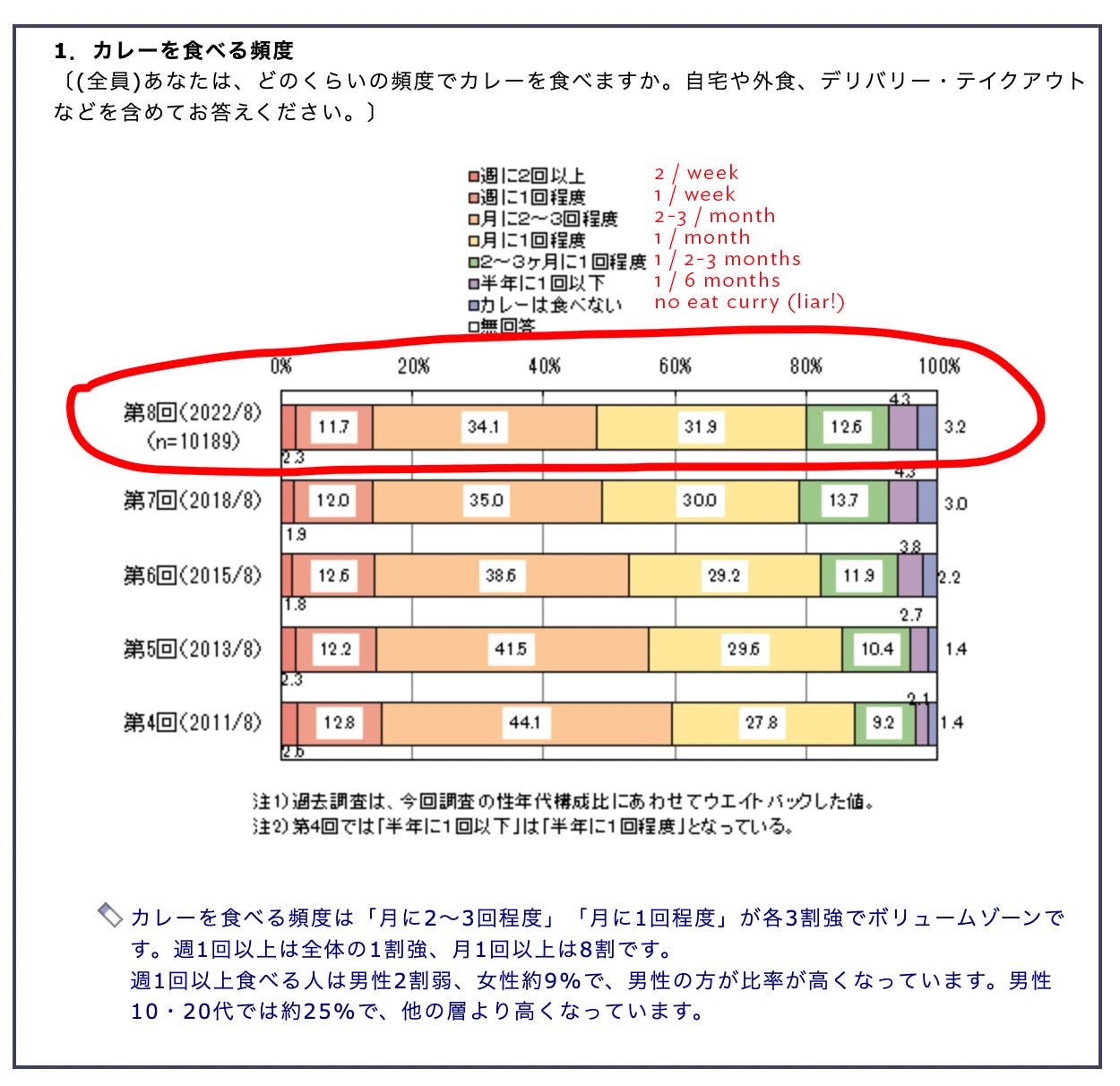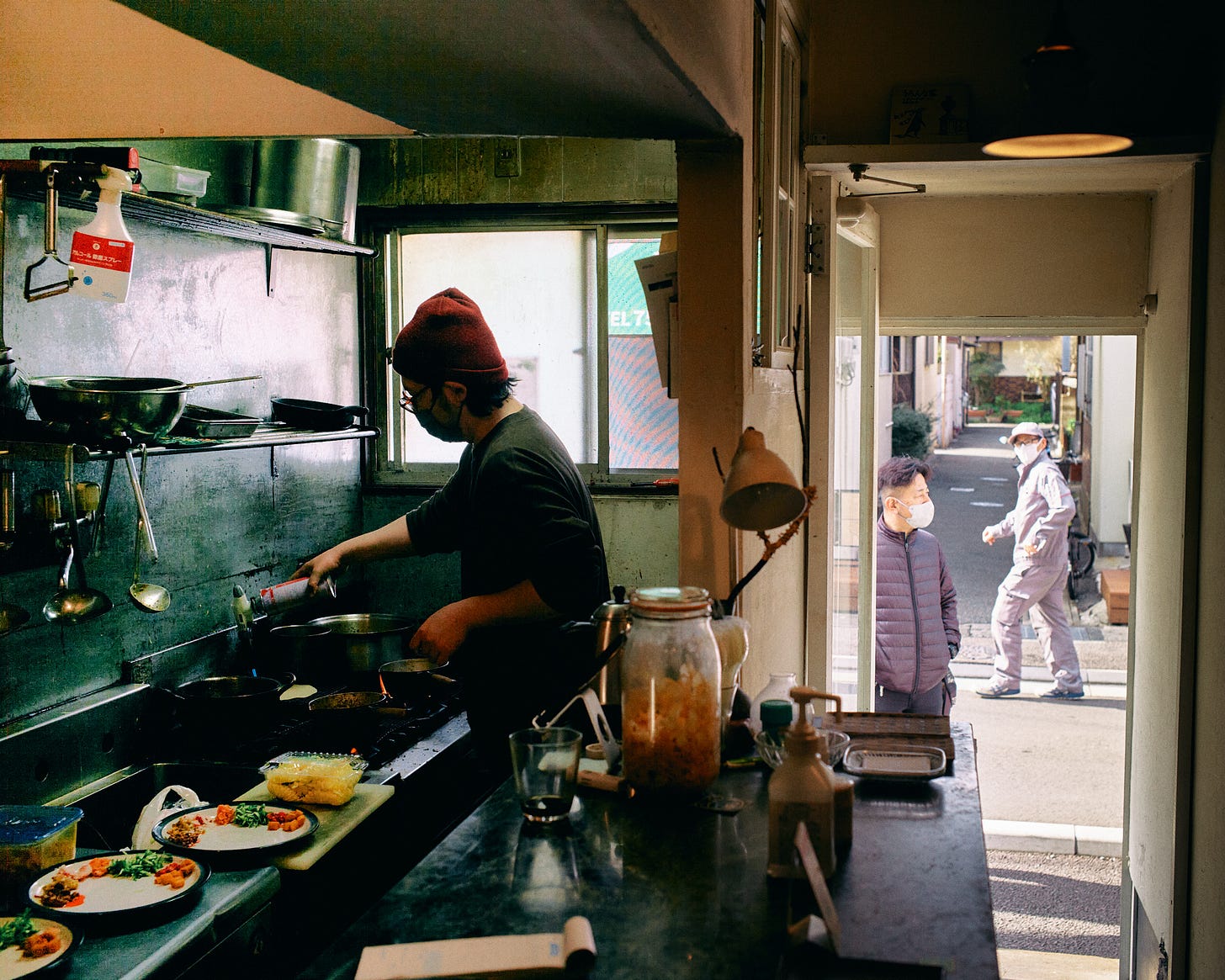Won't The Real Japanese National Dish Please Stand Up.
Quick, I say Japanese food and you say …
Lemme guess, ramen, sushi, sashimi, tempura, green tea, red bean, wagyu beef, udon, soba, miso soup, kaiseki, all of the yaki’s - takoyaki, okonomiyaki, taiyaki, yakisoba, yakitori … all of the don’s - gyudon, oyakodon, katsudon … all of the age’s - karaage, tatsuage, kakiage, kushiage, agedashi …
My point is, the first dish you eat when you land in Japan, the first place your host / friends take you to, is probably not what I’m about to reveal.
The national Japanese dish is curry.
I don’t think they ignore it on purpose.
It’s just in the blind spot, both domestic and internationally.
Like how you think England’s national dish is fish & chips, but it’s actually chicken tikka masala. See also: New York and pizza.
But let’s let the action do the talking, yes?
Please welcome, my favourite guest - charts!
*fangirl screams*

Let’s balance out the two extremes (once a week and once every 2-3 months) we can hastily conclude1 that Japanese admit to eating curry once every two weeks.
I’m annoyed to see that the total number has declined over the years, but if we compare it to the onigiri chart:

I bet you didn’t expect to learn that Japanese eat more curry than onigiri, did you?
The conclusion is people often lie, or are forgetful when it comes to food. (Have you not seen 12 Angry Men? Who remembers what they had for lunch yesterday anyway?)
Data is boring, here are some anedotal observations:
Kids can’t eat sashimi until they’re three, but you can find packs of Anpanman curry in the 12-month-old solid food section.
We were in an udon restaurant, and somehow, curry was on the menu.
We went to a pork cutlet restaurant, curry was on the menu.
Any canteen or family restaurant, curry on the menu.
Because if you don’t like anything else in the restaurant, there’s always curry.
Everybody loves curry.
Cook rice, chop up some vegetables, add proteins, water, the magic block of roux, and voila, dinner. The next best thing after instant noodles.
Mum makes curry, kids eat curry.
Kids grow up, kids have kids.
Repeat.
When I say Japanese curry, the default hive mind image is probably Coco Ichibanya, the McDonald’s of curry - pureed, goopy, smooth, served with Japanese rice and a side of everything under the sun.
They aren’t cheap too, a single curry rice dish with, say, a piece of fried pork cutlet, will deal 900 yen damage.
That’s on par with a high-end ramen restaurant.
That’s probably why ramen shop owners are secretly jealous of curry shop owners2. Customers are willing to pay more, the owners can inject more of their personalities into the shop, and there’s no ‘set image’ of a curry rice business model.
Most of all, curry’s range is so wide.
Check out Tabelog’s Top 20 curry restaurants and tell me it doesn’t look like a list generated by AI. There’s Indian curry, Thai curry, European curry …
When the range is so wide, people don’t know what they don’t know.
So they tend to be forgiving.
Here’s my own tried and tested food review system.
Make a list of restaurants, wait for a pandemic to happen, and three years later, if they’re still in business, it means they aren’t that bad.
I don’t know how Moritoneri and Afterglow got on my list.
Maybe I was flipping through a magazine or some TV program ages ago.
I don’t even know how Chika got my list.
Three years ago, she snuck off to the city with her sister to try Afterglow, while dumping me to pick up Hana from Japanese kindergarten.
And for three years, she wouldn’t shut up about it.
Life changing. Impactful. Unforgettable. Fwwwwa. You feel it from inside. Like a *wink* afterglow *wink*.
Good for you. Blood dripping down from fist.
Good for you. Squeezing the head of Hana’s soft toy.
Good for you. Slaps sourdough on the counter.
Last Monday, we finally had our first trip to the city alone to shop for Chika’s glasses.
Since we’re passing by Ropponmatsu, we stopped by Afterglow.
Alas, it was closed. It is the type of place that posts its monthly opening hours on Instagram; not Google.
Never mind, Moritoneri is just five minutes walk away, I looked at my list.
Moritoneri fits seven people.
From the counter, I saw everything. The spice racks, the stove.
The guy, with beard and beany, was so busy, he didn’t have time to serve us water.
Chika ordered the vegetable and chicken curry, and I the dry keema with added egg, coriander, and ‘pa-pa-do-’.
The menu was handwritten, and the space cosy.
There’s a bookshelf, but also a note to ask customers not to read and mess it up.
It’s like a third wave coffee shop that sells curry.
This is how it looks like when one person dedicates his life to ramen curry.
But once Chika said ‘sumimasen, I think there’s a hair on my plate’, I knew it was over.
No matter how quaint, minimal, and character-driven this shop appeared to be, that’s a strikeout.
I was just happy to be tasting anything at all.
Despite how we felt, the customers around us were enjoying themselves. They all left and told the shop owner how much they enjoyed their lunch. I later found out that people usually queue up up to an hour to taste his curry.
A week later, after making sure that they’re open, we made it to Afterglow.
It was definitely ‘louder’ than Moritoneri.
There were hand written signs outside - ‘mask is up to you’, ‘cash only’, ‘we don’t do takeaway’, ‘please do not disturb the neighbours while waiting’, ‘no toilet’.
Inside, the note gets progressively aggresive - ‘don't worry, everything is good here’, ‘if you can’t take spice, then your choice in life will be limited’, ‘sold out means sold out’, ‘if you don’t know certain words, please use your phone’ etc.
Are you looking for customers, or a fight3?
There’s a lady manning the customers, telling us the special, taking care of the cashier. The place fits up to 12 customers. A couple was taking turn holding their baby as they had their lunch.
Once again, we were lucky to find seats on the counter almost immediately. This time I managed to read some manga, architectural magazine, a zine on curry. All this while, a ‘Curry Grand Prix’ trophy staring at us from the corner. The owners pretending to not care, but actually do.
I ordered the ‘Sri Lanka Plate’, and it came out looking exactly like what I had the week before. Sure it’s not keema, but same idea, different execution.
Chika was right though, this place packs a heavier punch, towards the end I was wiping my forehead with sweat. She was happy that it wasn’t all a dream.
Moritoneri was the guy with an acoustic guitar; Afterglow is the more established rock duo with vocals and amplifier.
To be honest, both places did not serve the ‘curry’ that I’m used to.
Moritoneri probably served the more ‘Japanese’ curry; while Afterglow, with its stronger spice profile and basmati rice, feels more ‘exotic’. One had more female / hipster customers, the other tracksuits, salaryman, family, rough on the edges.
But both departed from the usual runny, gravy curry the world are used to. They try to introduce texture, pickled sourness, real spice.
Ask a guy from India though, he’d probably be amused by both.
As I said before, wider ranger - more forgiving reviews.
I doubt any of you traveling to Japan soon will go on a curry tour, but the takeaway is that curry has evolved to a form of self-expression.
It is way beyond fast food, and more than an afterthought.
I could do a ramen tour, but honestly, that sounds boring AF. Ultimately it’s a variation of noodles, stock, protein and egg.
If you want to experience local, but also a little left field, try curry.
So ahead of the curve, even the Japanese don’t know it’s their national dish.
Survey from MyVoice Enquette Library
Previously on Soy Sauce, Sugar, Mirin
I later found out they’ve been awarded a Michelin Bib Gourmand in 2019, and yea, yea, yea, 2020 Curry Grandprix, hence the cockiness.









